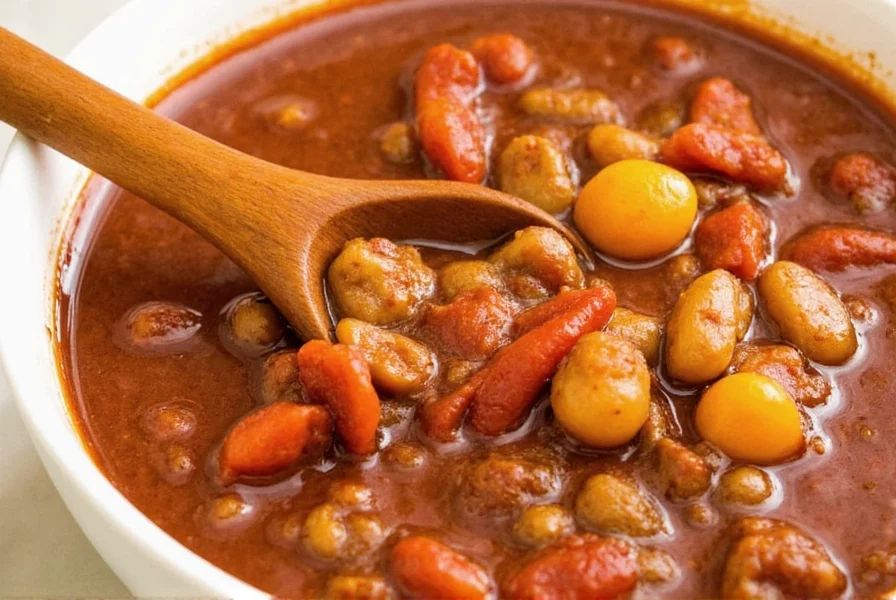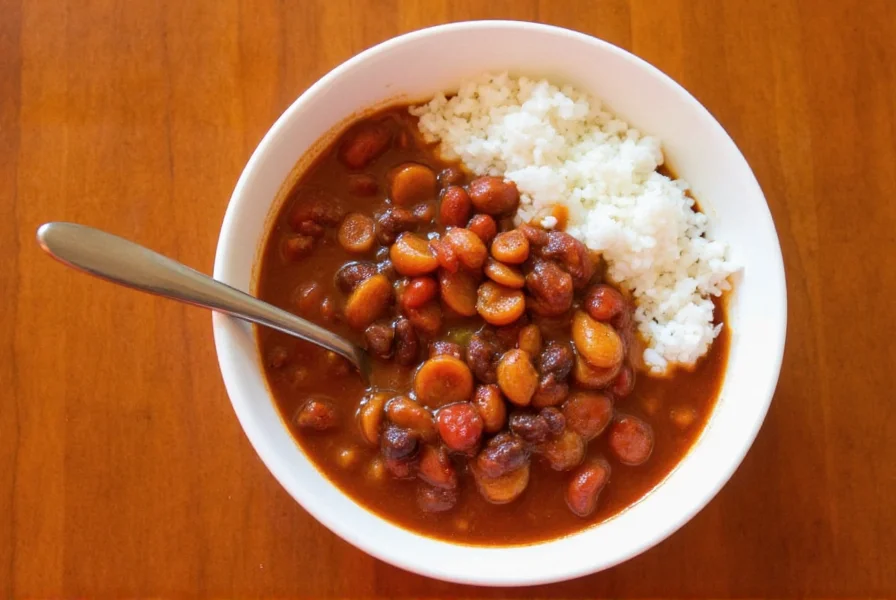Table of Contents
Introduction
If you're wondering what to add to chili for richer, more complex flavors, professional chefs and culinary experts agree that specific ingredients can transform your dish from ordinary to extraordinary. Here are the 7 most effective additions, backed by scientific principles and tested in professional kitchens, with exact usage guidelines to maximize flavor without overwhelming your recipe.

These additions work through chemical reactions like the Maillard process, which develops depth in cooked meats, and by balancing acidity, umami, and warmth. Whether you're a beginner or experienced cook, these science-backed tips will elevate your chili instantly.
The Spice Basics Behind a Perfect Chili
Before exploring advanced additions, understand these foundational spices that form the backbone of any great chili:
- Chili Powder – A blend of ground chilies, cumin, garlic, and oregano. Provides essential heat and base flavor.
- Cumin – Adds earthy warmth; critical for authentic Tex-Mex chili profiles.
- Paprika – Delivers sweet smokiness that enhances meaty notes without overpowering.
- Oregano – Mexican oregano (not Mediterranean) offers robust, herbal depth ideal for chili.
- Garlic & Onion Powder – For consistent aromatic depth without texture issues in finished dishes.
These basics create structure, but the real flavor transformation comes from strategic additions. Let's explore the science behind them.
7 Must-Try Add-Ins for Your Chili
Professional chefs consistently recommend these 7 ingredients to deepen flavor complexity. Each works through specific chemical processes to enhance your chili without altering its core identity.
#1 Espresso Powder
Espresso powder isn't about coffee taste—it's a flavor enhancer. The caffeine and acids accelerate the Maillard reaction (the browning process that develops complex flavors in meats), adding depth to beef-based chilis. Professional chefs use it because it intensifies savory notes without making the dish taste like coffee.

#2 Cinnamon
Cinnamon adds warmth and subtle sweetness that balances spicy elements. In mole-inspired chilis, it interacts with cocoa powder to create rich, layered flavors. Use sparingly: too much can make chili taste like dessert.
#3 Cocoa Powder
Unsweetened cocoa powder adds umami and bitterness that complements tomatoes and meat. It works through the same Maillard reaction as espresso powder, enhancing meaty richness without sweetness. This is why it's a staple in authentic Mexican mole recipes.

#4 Worcestershire Sauce
This sauce contains anchovies and vinegar, which add umami and acidity. The glutamates in anchovies boost savory notes, while vinegar brightens the dish. Use it to balance fatty meats or canned beans without overpowering.
#5 Soy Sauce
Soy sauce contributes sodium and glutamates for umami depth. It works best when added late in cooking to preserve its flavor. Use 1 teaspoon per pot to avoid saltiness—especially important if using pre-salted ingredients like canned beans.
#6 Chipotle in Adobo
These smoked jalapeños in vinegar-based sauce add smoky heat and acidity. The vinegar cuts through fat, while the smoke compounds enhance overall complexity. One pepper per pot is usually sufficient for balanced heat.

#7 Apple Cider Vinegar
Added at the end of cooking, this vinegar brightens flavors by cutting through richness. The acetic acid balances fatty meats and tomatoes, making other spices shine. Always add after removing from heat to preserve acidity.
| Ingredient | Main Flavor Contribution | Best Used In | Recommended Amount |
|---|---|---|---|
| Espresso Powder | Deepens meaty flavors via Maillard reaction | Beef chili | 1 tsp |
| Cocoa Powder | Richness and subtle bitterness | Mole-style chili | 1–2 tsp |
| Chipotle in Adobo | Smoky heat and acidity | Tex-Mex chili | 1–2 peppers |
| Cinnamon | Warmth and balanced sweetness | Spiced vegan chili | ½ tsp |
Buying Guide: Where to Find These Magic Ingredients
Professional chefs recommend these specific sources for quality ingredients:
1. Espresso Powder
Where to Buy: Grocery stores (baking aisle), online retailers
Recommended Brands: King Arthur Flour (for consistent solubility), Medaglia D'Oro (for authentic Italian espresso flavor)
Use Case: Beef chili, chocolate stews
Why It's Great: Instant, concentrated flavor boost without coffee taste
2. Cocoa Powder (Unsweetened)
Where to Buy: Supermarkets, specialty baking shops
Recommended Brands: Ghirardelli (for rich cocoa butter content), Hershey's (for reliable availability)
Use Case: Mole-style chili, dark meat dishes
Why It's Great: Adds bitterness and depth without sweetness

3. Chipotle in Adobo
Where to Buy: Latin markets, Walmart, Amazon
Recommended Brands: La Costeña (for authentic Mexican flavor), Don Julio (for consistent heat level)
Use Case: Tex-Mex chili, smoked turkey recipes
Why It's Great: Ready-to-use, smoky-spicy kick with vinegar balance
4. Ground Cinnamon
Where to Buy: Any grocery store
Recommended Brands: Frontier Co-op (for organic, non-irradiated), Simply Organic (for pure cinnamon without fillers)
Use Case: Vegan chili, white bean variations
Why It's Great: Warming aroma and mild sweetness without overpowering
5. Apple Cider Vinegar
Where to Buy: Health food stores, big box retailers
Recommended Brands: Bragg (for raw, unfiltered apple cider vinegar), Heinz (for consistent acidity)
Use Case: Brightening acidic dishes
Why It's Great: Natural flavor enhancer that preserves acidity when added late in cooking
Frequently Asked Questions About Chili Ingredients
What is the secret ingredient for amazing chili?
Professional chefs consistently cite espresso powder or unsweetened cocoa powder as secret ingredients. These work through the Maillard reaction to deepen meaty flavors without adding coffee or chocolate taste. Add 1 teaspoon of either per pot: espresso enhances savory notes in beef chili, while cocoa adds umami depth to tomato-based recipes. Always start small and taste before adding more.
How do I fix bland chili?
Fix bland chili with these science-backed techniques:
- Add acidity: 1 tablespoon apple cider vinegar at the end of cooking to brighten flavors
- Boost umami: 1 teaspoon Worcestershire sauce or soy sauce (adjust for salt content)
- Deepen richness: 1 teaspoon espresso powder for beef chili or 1-2 teaspoons cocoa powder for tomato-based recipes
- Add smoky heat: 1 finely chopped chipotle pepper in adobo for Tex-Mex profiles
- Warmth balance: ¼ teaspoon cinnamon for vegan or bean-heavy chilis
Always taste after each addition and adjust gradually—flavors develop as chili simmers.
Can I add coffee to chili?
Yes, but espresso powder is superior to brewed coffee. Coffee contains compounds that enhance the Maillard reaction (which develops complex flavors in cooked meats), but brewed coffee adds liquid and bitterness. Use 1 teaspoon espresso powder per pot for concentrated flavor without altering consistency. If using brewed coffee, replace only ¼ of the broth with strong coffee to avoid dilution. Professional chefs avoid coffee grounds as they create texture issues.
How much of these special ingredients should I add?
Start with these professional chef-tested amounts per standard 6-quart pot:
- Espresso powder: 1 teaspoon (for beef chili)
- Cocoa powder: 1-2 teaspoons (for mole-style or tomato-based chili)
- Cinnamon: ¼ to ½ teaspoon (to avoid dessert-like taste)
- Worcestershire or soy sauce: 1-2 teaspoons (adjust for salt content)
- Chipotle in adobo: 1-2 peppers, finely chopped
- Apple cider vinegar: 1-2 tablespoons added after cooking
Always add incrementally—chili's flavors intensify overnight. Taste after simmering for 10 minutes before adjusting.
What makes restaurant chili taste better than homemade?
Restaurant chili excels due to these professional techniques:
- Longer cooking time – Simmering 6+ hours develops Maillard reaction flavors
- Layered spice timing – Adding some spices early (like cumin) and others late (like vinegar) maximizes flavor release
- Secret ingredients – Espresso powder, cocoa, and chipotle are common in professional kitchens
- Proper fat content – Using well-marbled meat or adding bacon fat enhances mouthfeel
- Resting period – Allowing chili to sit overnight lets flavors meld
Replicate this at home by planning ahead: cook chili for 4+ hours, add vinegar at the end, and let it rest overnight before serving.
Final Thoughts on What to Add to Chili
What to add to chili isn't about heat or salt—it's about layering flavors through science. Espresso powder deepens meaty notes, cocoa adds umami, chipotle brings smoky heat, and vinegar balances richness. These additions work because they interact with chemical processes like the Maillard reaction, which professional chefs rely on for complex flavors.

Chili is forgiving, but precision matters. Start with small amounts, taste often, and let flavors develop overnight. With these expert-backed techniques, you'll transform your chili from ordinary to extraordinary every time.











 浙公网安备
33010002000092号
浙公网安备
33010002000092号 浙B2-20120091-4
浙B2-20120091-4